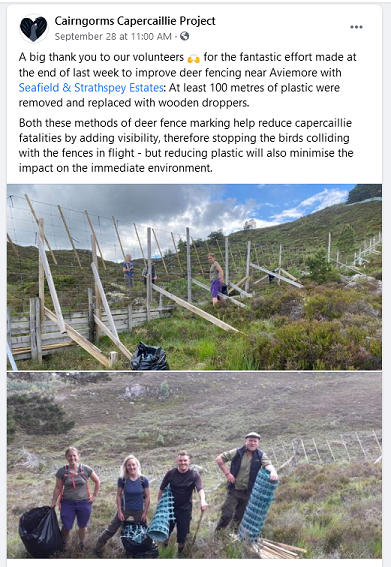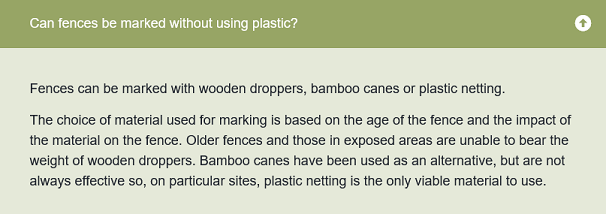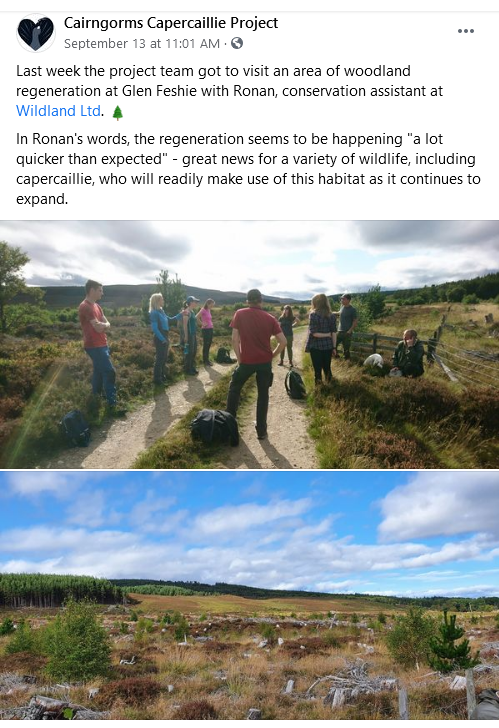
Following my post in June about capercaillie and fencing (see here), it is very good to see that the Cairngorms Capercaillie Project has been working with the Seafield Estate to replacing plastic netting on deer fences near Aviemore with wooden droppers. We should not be allowing plastic, whether in the form of netting or tree tubes (see here), to be used in woodland creation and our two National Parks should be taking the lead on this.
My understanding, however, is that in the past the Capercaillie Project, funded by the National Heritage Lottery Fund, has been responsible for putting up large amounts of plastic netting in an attempt to prevent capercaillie colliding with deer fences. The final question and answer at the bottom of their excellent webpage (see here) encouraging people to report unmarked deer fences would appear to confirm this:

While their Facebook Post appears to accept that plastic has an adverse impact on the natural environment, the Capercaillie Project still appears to be reserving the right to use it. This is an example of blinkered conservation thinking. Why not replace older fences rather than cover them in plastic since we know we need to keep plastic out of the natural environment? Or even better, remove the fences completely and control deer numbers instead?
Just two weeks earlier the Capercaillie Project had been to visit Glen Feshie, where Wildland Ltd have been removing deer fences, and seen how it should be done:

So why not follow this example? The problem appears to be that the Capercaillie Project has not been prepared to take on landowners. An example of this is a recent Capercaillie Project facebook post (see here) on the importance of habitat for capercaillie. This received a number of comment – well worth reading – from the gamekeeping lobby claiming the only way to save the capercaillie is predator control. Rather than challenging these claims, the Project’s lame response was to say they have employed their own gamekeeper!
The issue around Aviemore is not Seafield Estates, whom I believe are trying their best, but the other landowners up the Dulnain who have been failing to control deer numbers. What happens is that in winter deer descend from the high ground in the Monadliath down the Dulnain and eat the trees. Wildland Ltd had a similar issues with deer coming into the Feshie from Mar Lodge and Atholl, but have much greater resources than Seafield and been able to shoot the deer (and in doing so encouraged first the National Trust for Scotland and then Atholl to reduce deer numbers on their land).
A similar approach to reducing deer is needed around Aviemore and in the Dulnain, which is why what Brewdog does at Kinrara (see here) is so important. The Capercaillie Project could make a difference by calling on Brewdog to drop their current plans for planting trees within new fenced enclosures, reduce deer numbers and allow natural regeneration to work the wonders they witnessed on their visit to Glen Feshie.

The prombem with the Capercaillie is it don’t like living is Scotland Capercaillie have being introduced on 2 occasions and have more or less died out 21 thousand were again introduce from Sweden and their down to around 5or 6 thousand Give it up They don’t want to live in Scotland Especially in the LLNAP But keep useing them as a excuse to kill the Wallibes
There was a very interesting post on the Mar Lodge Estate Facebook page where they were trialling the use of sheep wool on saplings to deter nibbles by deer. Apparently there is evidence that it works. I shall watch with interest because if it works, then surely it would be the cheapest, simplest, most sustainable solution to the plastic tube problem.
There was a comment highlighting that some company somewhere was hoping to produce tubes made out of wool which would be available next year.